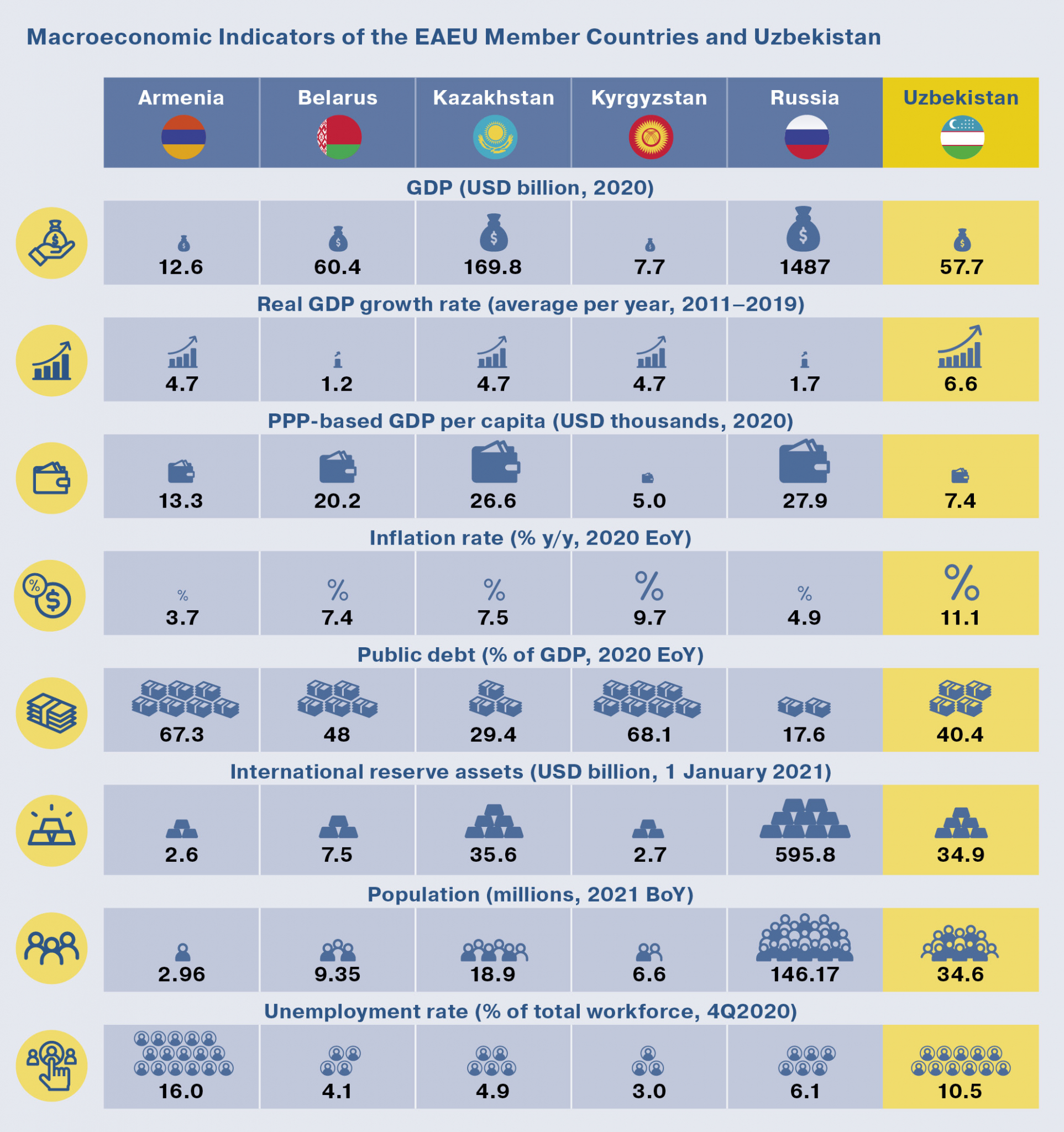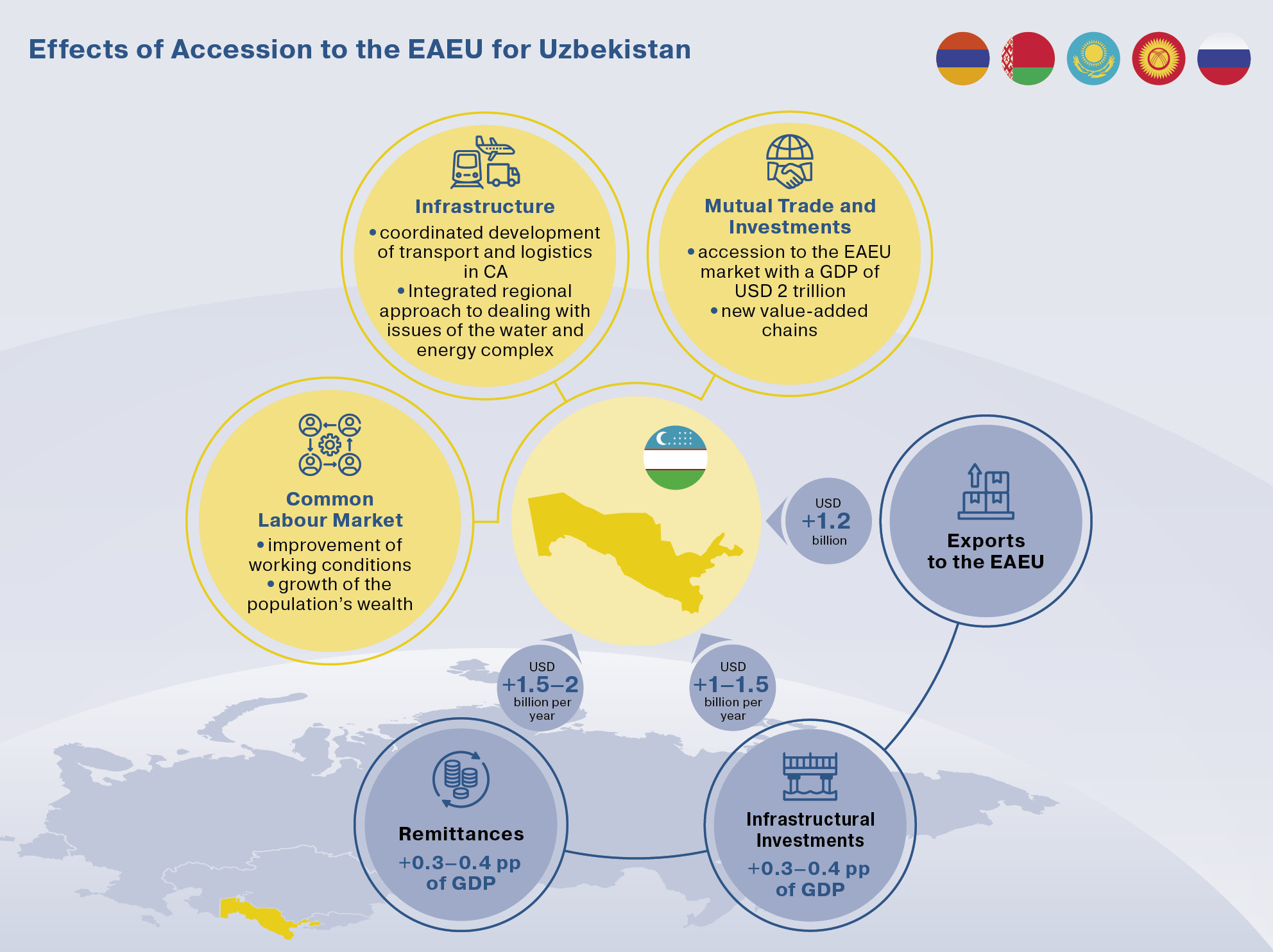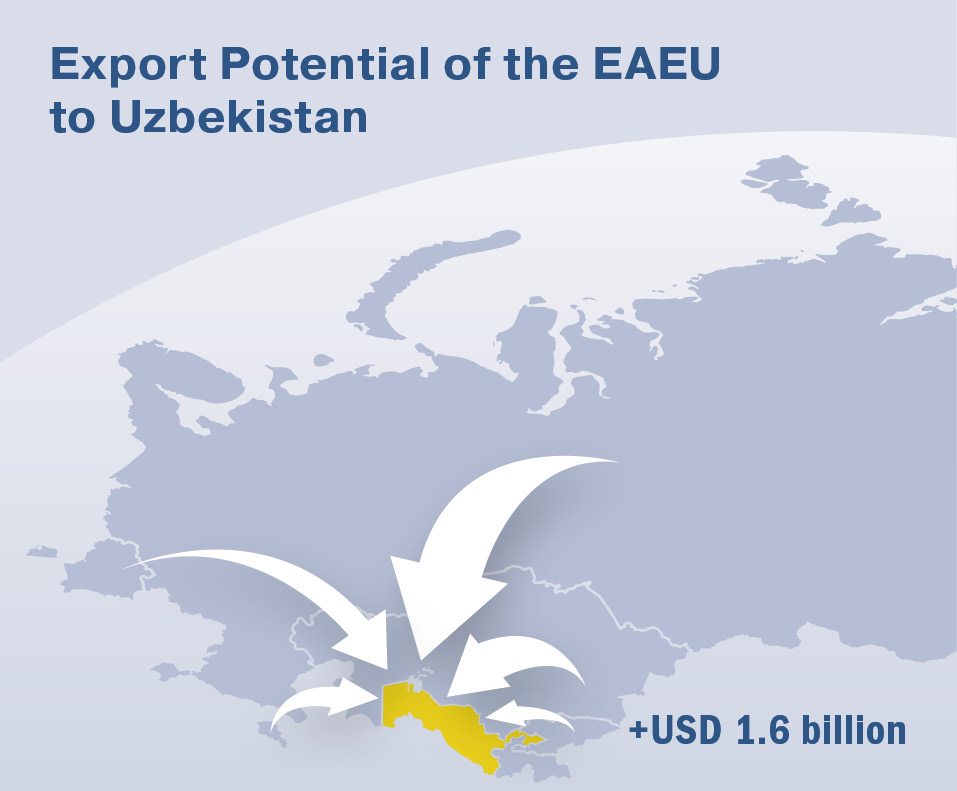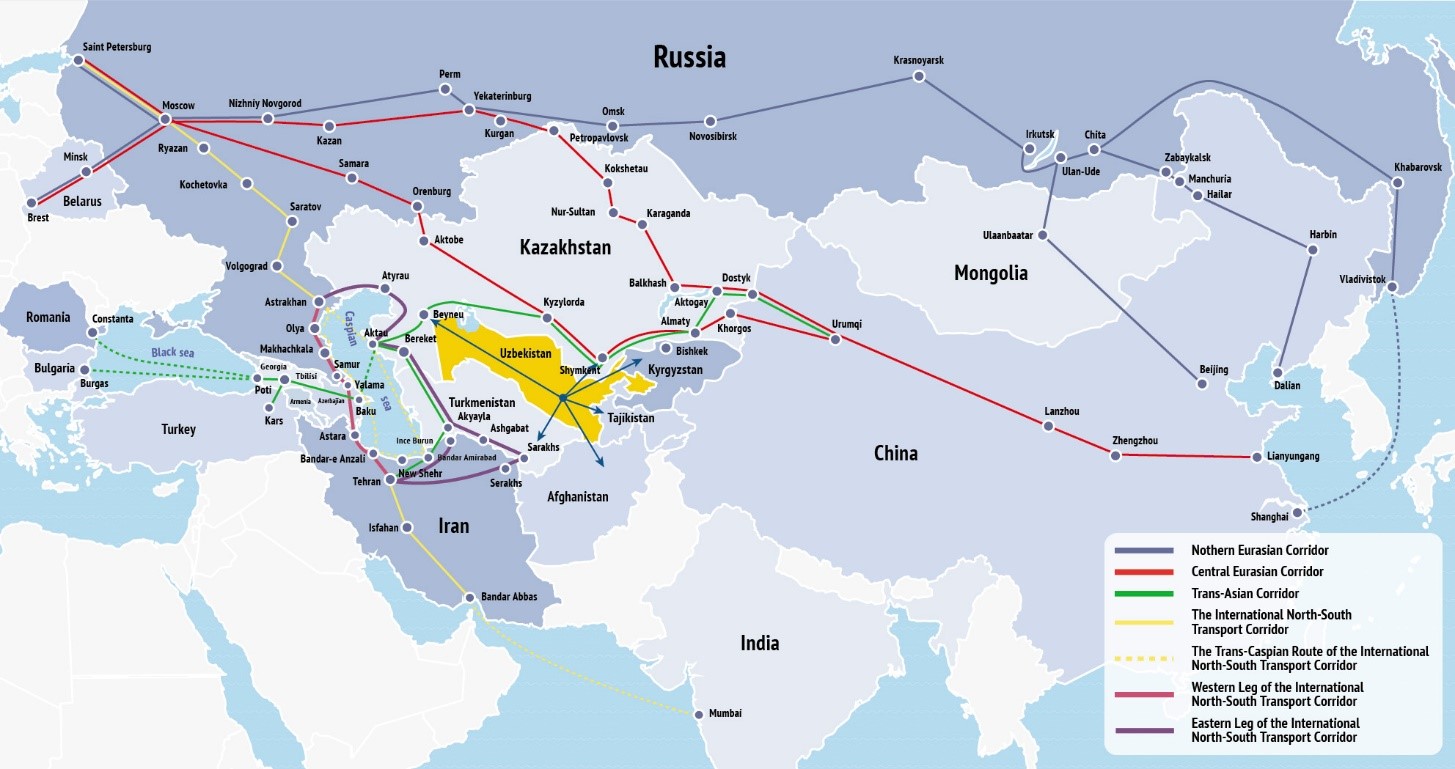The EDB publishes report titled Uzbekistan and the EAEU: Prospects and Potential Impact of Economic Integration
The Eurasian Development Bank’s analysts have assessed the potential effects of Uzbekistan’s integration with the Eurasian Economic Union (EAEU, the Union). Integration is expected to benefit both Uzbekistan and the current EAEU member states. The EAEU’s potential infrastructure investments in Uzbekistan are estimated at $1-1.5 billion annually. Additional remittances to Uzbekistan could average $1.5-2 billion a year. The country’s exports to EAEU member countries may grow by an extra $1.2 billion. The current EAEU member states are expected to expand industrial cooperation and investment presence in the country and intensify cross-border infrastructure projects. The unrealised potential of EAEU exports to Uzbekistan is estimated at $1.6 billion.
Moscow, 1 July 2021. The Eurasian Development Bank (EDB, the Bank) has published a report titled Uzbekistan and the EAEU: Prospects and Potential Impact of Economic Integration, which estimates the potential effects of Uzbekistan’s integration with the EAEU and outlines promising areas for cooperation between the current Union member states and Uzbekistan.
Uzbekistan is a large economy in Central Asia with a GDP of $57.7 billion and a population of 34.6 million in 2020. It is rich in natural resources and has a well-developed manufacturing base. In dollar terms, Uzbekistan’s GDP is equivalent to slightly more than 3% of the aggregate EAEU GDP and is comparable to that of Belarus.
The report notes that Uzbekistan’s economy grew at an average of 6.6% in 2011–2019, which is more than in the EAEU member states. Yet, despite high economic growth rates, the income gap between the country and the EAEU member states remains significant. One reason for this is the low productivity of economic sectors, which is, for example, two times lower for agriculture compared to Russia or Belarus, and four times lower for manufacturing and construction than in Kazakhstan. Increase in economic productivity is hampered by a lack of investments, technologies, and by the current state of physical infrastructure.

The structural changes and economic reforms initiated in 2017 by Uzbekistan’s government are visibly transforming the economy. However, the country still needs to promote infrastructural development, improved access to global and regional markets, and a favourable institutional environment. The authors believe that economic and institutional support that would result from integration with the EAEU should foster Uzbekistan’s comprehensive development.
What economic effects could Uzbekistan reap from integration?
EDB analysts estimate that infrastructure investments from the EAEU in Uzbekistan could reach as much as $1–1.5 billion annually. This would add 0.3-0.4 p.p. to real GDP growth per year. Bank experts believe that Uzbekistan is an attractive business and FDI destination for the current EAEU member states. Companies from EAEU countries are interested in building up cooperation with the country’s enterprises.
Access to the common EAEU labour market would generate additional remittances to Uzbekistan at an average of $1.5-2 billion per year. The authors estimate that this should add 0.3–0.4 p.p. to annual real GDP growth. In addition, labour migration to EAEU member states should help to mitigate socio-economic tensions in the country caused by unemployment and underemployment.
In terms of depth of integration, the EAEU’s common labour market is comparable to that of the European Union. It offers simplified registration procedures for migrant workers, legal employment, and all types of social benefits throughout the Union, including health care, education, mutual recognition of university degrees, as well as pension schemes.
Another significant benefit from deeper integration for Uzbekistan is the possibility to boost exports to the current EAEU member states by an additional $1.2 billion. By comparison, in 2020 the country’s exports to the EAEU totalled $3 billion. Increased supply by Uzbekistan’s exporters is possible not only to Russia as the key trading partner but to all EDB member countries.

As for the current EAEU member states, their full integration with Uzbekistan should also stimulate exports to its large consumer market. EDB analysts estimate the unrealised potential of EAEU exports to Uzbekistan at $1.6 billion.

Another advantage of the EAEU member states’ economic integration with Uzbekistan should be access to its labour resources and raw materials. This is expected to foster economic cooperation within the EAEU. The free movement of goods, services, capital, and labour should help to promote the expansion of businesses in Uzbekistan. For the Union as a whole, resource crossflows will improve the efficiency of the industrial base and make its goods more competitive.
The authors also believe that facilitating access to the EAEU labour market for migrant workers from Uzbekistan should help offset labour shortages in the Union in several sectors. At the same time, Uzbekistan’s possible accession to the EAEU will enhance competition among migrant workers from Armenia, the Kyrgyz Republic, and Tajikistan, among other things, in consequence of the numerical superiority of migrants from Uzbekistan.
“It would be difficult to facilitate an efficient regional development without Uzbekistan, which is a major and strategically located player in Central Asia,” comments Evgeny Vinokurov, EDB and EFSD Chief Economist. “This fully relates to the transport, logistics, and the water and energy complex. The depth and intensity of Uzbekistan’s engagement in regional and Eurasian integration processes will determine their sustainability and success. Uzbekistan’s greater economic integration with the EAEU could significantly boost economic cooperation in the region.”

Uzbekistan is one of the key countries at the Central Asian crossroads of international West–East and North–South transport routes. The country’s integration into the EAEU should facilitate the completion and operation of the Trans-Eurasian transport corridors, among other things, through participation in One Belt, One Road Initiative. Alignment of Uzbekistan’s interests with those of the EDB member countries and intensification of their collaboration will improve the chances of raising additional funding for the republic’s transport and logistics infrastructure.
EDB analysts conclude that the lack of investments in Uzbekistan’s transport and logistics infrastructure directly impacts the time en route and quality of transport service, and hikes transport and network operating costs. As a result, the economy does not fully benefit from its potential and regional trade. According to the report, the funding needs of Uzbekistan’s transport infrastructure until 2030 may amount to about 2.1% of GDP per year.
In addition, Uzbekistan’s accession to the EAEU and the EDB should contribute to the coordinated development of Central Asia’s water and energy complex. Due to the complementary nature of its grid architecture, power generation structure, and water resources management system, Central Asia’s water and energy complex will remain viable only if energy and water use issues faced by the region are resolved in an integrated fashion. Uzbekistan, like other Central Asian countries, needs new approaches to shape and regulate the regional market. These should be based on state-of-the-art technologies and digital solutions.
The report concludes that sustainable long-term economic development will depend on the advancement of trade and economic ties among the region’s countries based on effective projects (production facilities). Such projects need to be globally competitive. Development of the integration association should not pursue “expansion for the sake of expansion”. That path will ultimately impair the efficiency of the regional organisation.
The report titled Uzbekistan and the EAEU: Prospects and Potential Impact of Economic Integration is available here.
Other reports by the EDB and EBRD are available in the Research section on the Bank’s website and the Publications section on the Fund’s website.
Additional Information:
The Eurasian Development Bank (EDB) is an international financial institution promoting integration and development in its member countries – Armenia, Belarus, Kazakhstan, the Kyrgyz Republic, Russia, and Tajikistan. The EDB's charter capital totals US $7 billion. The Bank was established in January 2006 and is headquartered in Almaty. The EDB’s portfolio mainly consists of projects with an integration effect in the areas of transport infrastructure, digitalisation, green energy, agriculture, industry, and mechanical engineering.
The Eurasian Fund for Stabilization and Development (EFSD) amounting to US$8.513 billion was formed on 9 June 2009 by the governments of the same six countries. The EFSD assists its member states in overcoming the consequences of the global financial crisis, ensuring their economic and financial stability, and fostering integration in the region. The EFSD member countries signed the Fund Management Agreement with Eurasian Development Bank giving it the role of the EFSD Resources Manager.
The EDB Media Centre:
Azima Sapargaliyeva +7 (777) 750 00 08 (Almaty)
Sergey Gorbachev +7 (916) 727 22 00 (Moscow)
